AMD Radeon HD 4670: Ruling from Top to Bottom
by Derek Wilson on September 10, 2008 12:00 AM EST- Posted in
- GPUs
ATI vs. NVIDIA Once Again: 4670 vs 9500 GT & 9600 GSO
Now we get into the real competition. We're looking at AMD's newest mainstream card vs. NVIDIA's two latest entries into the sub $100 market. The 9600 GSO is just an 8800 GS. Though we didn't compare it here, the 9600 GT is priced right around $100 and offers performance a little better than the 9600 GSO. While we are comparing with the 9500 GT here, it will become quickly apparent that the card doesn't even come close to competing with the 4670.
For our medium quality Crysis test, the 4670 seems framelimited at about 60 here, while the 9600 GSO seems to push past the 60 fps barrier. At 1280x1024 and above, the 4670 leads the pack by a small margin in this benchmark.
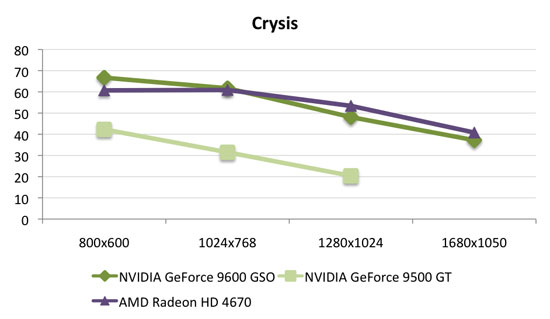
Enemy Territory with 4xAA enabled shows a huge advantage for the 4670 over NVIDIA's more expensive 9600 GSO. Even so, the NVIDIA cards remain playable at 1280x1024, so the practical advantage is a little decreased until we get to 1680x1050.
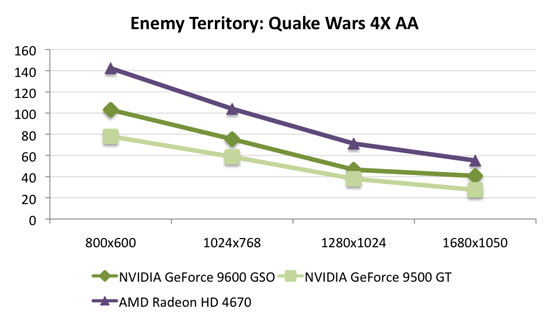
Once again Oblivion offers us a role reversal when AA is enabled. Without AA, the 4670 falls behind above 1024x768, while it pulls a little ahead when 4xAA is enabled. Again, the 4670 and 9600 GSO are playable at 1280x1024 with AA, and might both be passable at 1680x1050 as well (Oblivion is a game that still offers a good experience at anything above 25 fps).
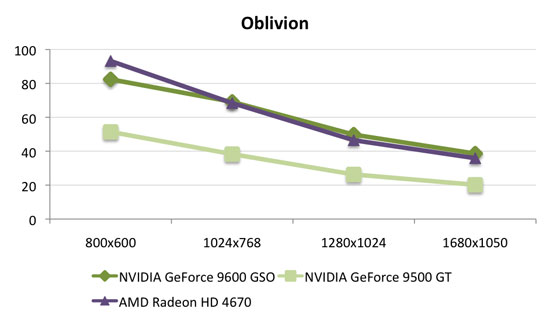
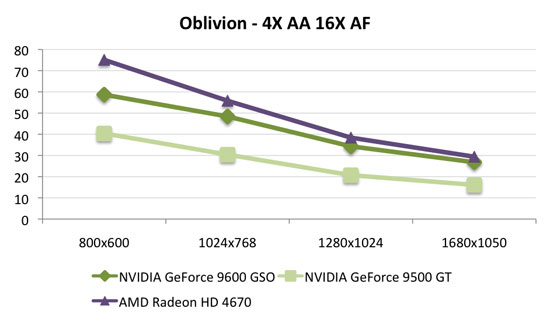
The 9600 GSO maintains a steady ~10% lead over the 4670 in Age of Conan. This is quite an interesting benchmark for NVIDIA to lead considering how handily they are clobbered at higher price points by the 4850 and 4870.
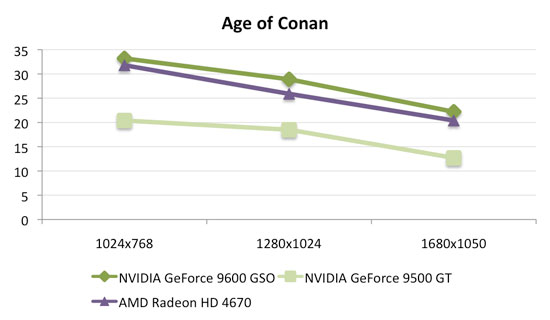
Performance in GRID is nearly identical between the 4670 and 9600 GSO.

Throw AA in there and we see a little separation trying to happen, but the 9600 GSO actually does keep up at lower resolutions with AA.
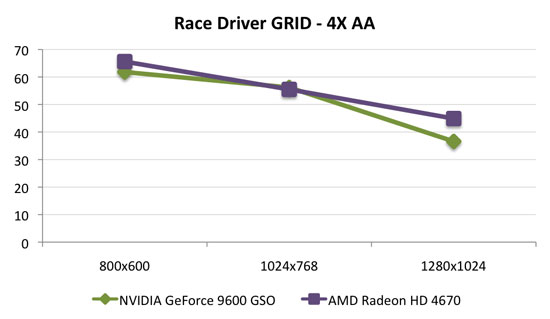
For The Witcher, while the 4670 leads at lower resolutions, performance converges at higher res. Both are playable at 1280x1024. We wanted to test AA in this one, but it is sort of difficult as the game limits the ability to enable AA based on framebuffer sizes; thus we couldn't enable 4xAA past 1024x768 on the 9600 GSO.
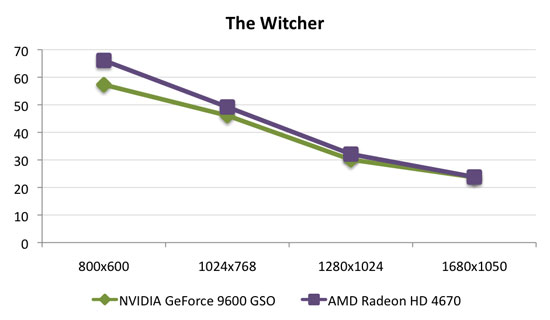
When we hit high quality Crysis, the 4670 leads.

And the lead just gets bigger if we look at medium quality (high quality shaders) with 4xAA enabled. The 4670 is borderline playable in this situation at 1280x1024 while the 9600 GSO falls way short.











90 Comments
View All Comments
Pale Rider - Thursday, September 11, 2008 - link
Yes I can blame them. Those nVidia products are featured in their own reviews WITHOUT ATI product information.nVidia has AT in their pocket.
whatthehey - Thursday, September 11, 2008 - link
The great thing about accusations like this is that there's nothing Anandtech can say in response. It's just a complete bullshit assertion made by fanboys (or idiots, take your pick).I look at the 9500 GT and I read, "This is not an exciting launch. The 9500 GT doesn't offer much more performance than the 8600 GT it replaces." I see charts with the 3850 and 3650 included. I read comments about how both ATI and NVIDIA have released pretty weak hardware at the bottom.
I read the 4870X2 article and I see sensible explanations about how Crossfire doesn't always work, the card is expensive, but when everything gels it's a very fast solution. Where's the bias there? Where's the "lies"? I'll tell you what, I've got my Crossfire system and I can say without a doubt that there are plenty of games that don't scale with CF. Especially new releases where ATI hasn't had a chance to update the drivers. Quite a few titles require you to run with CF disabled until the next driver update, or else performance is horrible. (Grid is a perfect example. I think I got about 3 FPS with Crossfire 3870 at launch, but around 30-40 FPS when I disabled CF.)
Or what about the totally NVIDIA biased review of the GTX 280? "As impressive as the GT200 is, the GeForce GTX 280 is simply overpriced for the performance it delivers. It is NVIDIA's fastest single-card, single-GPU solution, but for $150 less than a GTX 280 you get a faster graphics card with NVIDIA's own GeForce 9800 GX2. The obvious downside to the GX2 over the GTX 280 is that it is a multi-GPU card and there are going to be some situations where it doesn't scale well, but overall it is a far better buy than the GTX 280." And it's a good thing they don't mention ATI in NVIDIA reviews, like this statement: "The GeForce GTX 260 is a bit more reasonable. At $400 it is generally equal to if not faster than the Radeon HD 3870 X2, and with no other NVIDIA cards occupying the $400 pricepoint it is without a competitor within its own family. Unfortunately, 8800 GT SLI is much cheaper and many people already have an 8800 GT they could augment."
The fact that ATI is second on a lot of launches is the cause for the comparisons that are done. (GT200 came before the HD 4800 launch, so it was compared to 3870X2; 4670 followed 9500; plenty more examples that I won't bother to list) What about the "totally anti-AMD" article praising the 4850 and 4870: "The Radeon HD 4870 and 4850 are both solid values and cards we would absolutely recommend to readers looking for hardware at the $200 and $300 price points." That makes sense, and the conclusions in this article make sense to me as well.
For the price, you get a decent card, but there's no denying the 4670 will struggle in quite a few games, particularly at higher resolutoisn. I can't imagine running anything less than a 22" 1680x1050 display these days, and the only people running 19" LCDs are already using older hardware. Once you go widescreen, you'll never want to go back... at least not until you encounter one of the titles that refuses to include WS support.
So sure, if you're limping along with older hardware this makes sense. If you don't care too much about gaming performance, it's a great HTPC card, but do most people actually use HTPCs!? I think it's just a really vocal minority that chooses to bitch about HTPC issues, because I'd take my DVR over any of the PC solutions for $10 a month and the ease of use and integration! I can't remember the last time anyone in my family asked me for help trying to connect their PC to a TV - HD or otherwise. The real truth is that the only people that really need discrete GPUs are enthusiasts and gamers. If you're a gamer, get something faster for a bit more money. If you're like Anand and building a $50000 home theater, I suppose it's just too much to consider that extra money for more performance? If I had a nice setup for watching movies, I'm certain I'd want to use it to play games on occasion as well.
strikeback03 - Thursday, September 11, 2008 - link
The 9600 GSO has been around for at least 3-4 months, just was not exciting enough to warrant mention. Look on the bright side - every GPU AMD has released recently has been important enough to get a full review, while we have rehashed NVIDIA GPUs that are not mentioned until they compete with something from AMD.superflex - Wednesday, September 10, 2008 - link
Thanks for another biased anti AMD review Anand. The 4870 and 4870 X2 reviews must have been your template.The reviews on this site are becoming a joke. Graphs and text dont match, bias is evident, and conclusions are skewed.
I agree using a quad core CPU is stupid when evaluating a <$80 GPU. No one who spends that kind of jack on a CPU, mobo and memory is going to cheap out on the GPU.
The test system ought to be someting the average joe would have. Not Anand's dreamy Intel (read not AMD) system.
themadmilkman - Wednesday, September 10, 2008 - link
Using a quad core CPU isn't stupid, it's good methodology. The whole idea is to try and avoid any external limitations on the card's performance, so that the only change we see IS the card's performance.Seriously, this is a technical website. If you don't want to see things done by the appropriate technical method, go read cnet.
geok1ng - Wednesday, September 10, 2008 - link
Again the very same crap: NVIDIA selling the same hardware with a new name.Maybe seeing the market share going away at the top, mid and low end market they will start to offers us better and cheaper cards.
As for ATI: excellent pricing for a great card! Now how about putting some money on the drivers division?! All ATI cards need better drivers ASAP!
MrPickins - Wednesday, September 10, 2008 - link
The real reason I'm waiting for this card is for my HTPC so I can use HDMI for video and multichannel audio, in a low power card. :Dhelldrell666 - Wednesday, September 10, 2008 - link
...........Spacecomber - Wednesday, September 10, 2008 - link
Is it safe to assume that all the cards that were discussed in this review (not just the 4670 and 4650, but also the cards they were compared to) are equal in their video acceleration capabilities? Maybe this is a given, but I wasn't sure.It seems like the capabilities of these lower end cards for doing things besides 3D gaming become more important, since they aren't really of much interest to a dedicated gamer. Something like a HTPC seems like a more likely home for one of these cards, or a general purpose home computer that might get pressed into service for some home video editing (though I'm assuming CPU power is what still counts the most for this sort of work).
tripomarto - Wednesday, September 10, 2008 - link
i really dont understand why you benchmark a 80$ gpu in a system with a 1000$ cpu, may be you can make 3 reference system, one for high, one for medium, and one for low budget, it may reflect the real performance that people buying this card will see...